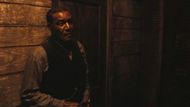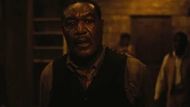Amidst a film full of musical mysticism, Southern folklore, and vampire horror, one character stands head and shoulders above the rest, not only as a side character but as the soulful pulse of Sinners. Delta Slim, played magnificently by Delroy Lindo, is more than a sidekick or a comic relief. He's a flesh-and-blood representation of the Mississippi Delta's cultural heritage while showing the strength of a reluctant hero. From the scene he enters, Slim commands attention with a presence honed in storytelling, melody, and wisdom.
Released on April 18, 2025, with Sinners evolving as a survival story, a musical, with supernatural elements, it's Delta Slim who repeatedly anchors anarchy with humor, heart, and history. Whether he's battling vampires or stand-up-comic-ing in the heat, Slim is everybody's favorite not just for what he does but for what he symbolizes. Every one of his scenes provides more than a simple surface-level entertainment; they resonate with generational hardship, creativity, and defiance. These seven moments show why Delta Slim is not only another character, but is the heart of Sinners.
These 7 Delta Slim moments from Sinners made the character epic
1. Introducing Preacherboy Sammie at the Juke Joint Opening

Delta Slim's greeting of Sammie at the juke joint is not merely a welcome, it's a symbolic passing of the baton. The warmth in his tone and the look of pride in his eyes are reminiscent of an elder one blessing the younger generation. Against the rich musical ground of Clarksdale, Mississippi, the scene shows how music weaves together history, family, and identity. Slim's character serves as the emotional center, and his presence validates the juke joint not only as a performance venue but as a safe haven. Critics universally praised Delroy Lindo's gravitas in this scene, labeling it as one of the most "soulful and magnetic entrances" of the film.
2. Participation in the Transcendent Musical Performance

When rhythms swell, the joint transitions into a liminal realm between the living and the deceased. Slim's performance of the blues calls up ancestors and even broaches futuristic energies. This genre-bending moment left crowds and critics agog, likening it to Black Panther's ancestral plane sequences. The music isn't entertainment; it's resistance and resurrection tied together. Coogler mentioned in interviews that Lindo's improvisation during the rehearsals contributed to the depth of the scene. This momentous sequence was a reminder to viewers why Black music is both revolutionary and historical, and Slim is its proud vessel.
3. The Garlic Test Scene

In a horror-comedy reversal, Delta Slim is the focus of a garlic test on suspicion of vampirism. His exaggerated response, attributed later to Irish beer, provides comic relief amidst fear. This whole scene is homage to The Thing, with group paranoia and nutty tension. The humor doesn't undermine the fear; it makes it human. Delroy Lindo is said to have insisted on this moment, using it as an opportunity to make fun of vulnerability. Fans adored the mix of comedy and horror, with the scene trending on social media and netizens referencing Slim's response. The scene is useful in lightening the mood of the film without diluting its thematic impact.
4. Sacrificing Himself for the Survivors

In an act of profound sacrifice, Delta Slim sacrifices himself to save Sammie, Pearline, and Smoke from the vampire assault. It's not only heroic, it's freighted with generational symbolism. Slim is the past, graciously stepping out of the way to preserve the future. His death, though tragic, rings with a sense of honor and purpose. Coogler choreographs this scene through ominous lighting and sparse scoring, allowing Lindo's acting to bear the weight of emotion. Critics compared the scene to Obi-Wan in Star Wars, referring to it as a "spiritual handoff." It raises Slim from the status of comic relief to that of a tragic hero, solidifying his place at the heart of the story.
5. Confrontation with Vampire Annie

Delta Slim's battle with the vampiric Annie is a gut-wrenching, emotional fight. Once close friends, their brutal encounter captures the terror of losing someone to the darkness. Slim kills her, but not before he takes fatal wounds himself. The scene exacts an emotional and physical toll that adds gravity to his journey. The suspense is expertly built, fueled by Lindo's emotional complexity. The choreography balances supernatural action and real-world sorrow well. Coogler confirmed that the sequence was inspired by traditional Western standoffs, which lent the scene a distinct visual grit. It is more than a vampire fight. It's an emblem of facing tainted love and the sacrifices that heroes have to make, even if it destroys them.
6. Providing Comic Relief Amidst Tension

Even during the blood-soaked anarchy, Delta Slim provides unforgettable humor. His joke, "You don't smell anything? I think I smell myself," made the audience laugh out loud, while becoming an internet sensation in itself. It's honest and flawlessly timed, imbuing the film with much-needed humanity amidst horror. The joke was built around a bit reportedly from one of the blues greats, Bobby Rush, which inspired the character's origin story. Coogler let Lindo improvise, tapping into the spirit of Southern storytelling where humor masks terror. This moment also had elements of cultural realism, illustrating how cultures utilize comedy to cope with trauma. It's proof that in Sinners, even a throwaway line is filled with soul, history, and authenticity.
7. Embodiment of Cultural Legacy

Delta Slim doesn't just exist in the narrative; he embodies it. He is a symbol of bridging generations, inheriting the blues spirit and Southern perseverance. Through his music, Slim brings the Delta's cultural essence to life. Critics lauded Lindo's performance as the stabilizing anchor of the film. Lindo's character was based on real-life blues musicians and was influenced by Coogler's interviews of Mississippi residents. Slim's appearance reinforces that Sinners is not only a horror film, it's a document of cultural preservation in celluloid. With each chord he draws and each line he utters, Delta Slim reminds viewers that history is not merely remembered, it's performed.
Delta Slim's odyssey in Sinners isn't only memorable, it's iconic. With humor, heartache, and heroism, he emerges as the emotional backbone of the narrative, combining legacy across generations with everyday bravery. Every one of his scenes speaks to something bigger than the story: music's strength, community's significance, and the heart of the South. Delroy Lindo's unforgettable performance makes the memory of Slim linger in the minds of viewers long after the credits have stopped rolling. In a film full of daring moments and supernatural surprises, it's the humanity of Delta Slim that keeps Sinners grounded.
Love movies? Try our Box Office Game and Movie Grid Game to test your film knowledge and have some fun!
